HIS Radeon HD 6930 IceQ X 1 GB Graphics Card Review

Without much hype and big promises AMD launched a graphics accelerator that not only took its place in the company’s product lineup, but also called in questions about the existence of three other graphics cards in the family. Our today’s review will unveil which graphics cards these are and why it happened in the first place.
In late 2011 AMD tried to find some profitable use for defective Cayman chips that were collecting dust at warehouses. How else can we explain the limited release of the Radeon HD 6930 graphics card in not one but two versions, with 1 and 2 gigabytes of onboard memory? It wasn’t easy to fit the new product into AMD’s tight lineup as the closest models, Radeon HD 6950 2GB and Radeon HD 6870 1GB, are priced at $239 and $189, respectively.
Let’s see how the new Radeon HD 6930 compares with them from a technical standpoint:
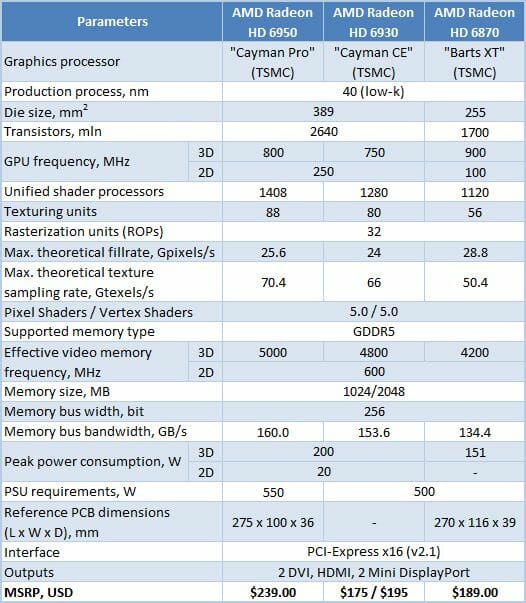
So, the Radeon HD 6930 has 128 unified shader processors and 8 texture-mapping units less than the Radeon HD 6950 and its GPU clock rate is 50 MHz lower. Comparing the Cayman CE with the Barts XT based product, we can see that, besides architectural differences, the former’s GPU clock rate is 250 MHz lower but memory clock rate is 600 MHz higher. The three cards seem to have no other serious differences.
It would be logical for the Radeon HD 6930 to be positioned somewhere in between the other two. However, its 1GB version comes at a recommended price of $175 while the 2GB version, a mere $20 more. And the actual Radeon HD 6930 prices are indeed close to the recommended one, which makes the new card a very attractive buy, especially compared to the HD 6870.
Besides limiting the period of production (presumably the first quarter of 2012), AMD restricted the geography of the Radeon HD 6930. It comes to Russian and Chinese markets and will only be produced by three companies: PowerColor, Sapphire and Hightech Information System. It is the latter’s Radeon HD 6930 IceQ X 1GB that we are going to talk about today.
Packaging and Accessories
The new graphics card is packed into a small nice-looking white-and-blue box.
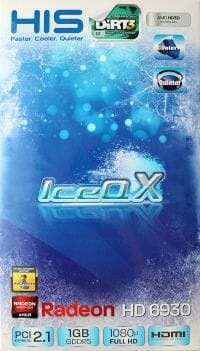
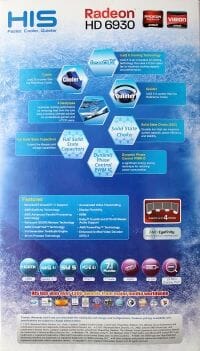
The frosty letters “IceQ X” refer to HIS’s exclusive cooling system, suggesting that it is highly efficient. Key product features are indicated at the top and bottom of the box with icons. The same information is detailed on the back of the box.
The HIS Radeon HD 6930 IceQ X can be found in the central compartment of the box. The following accessories lie on top of it:
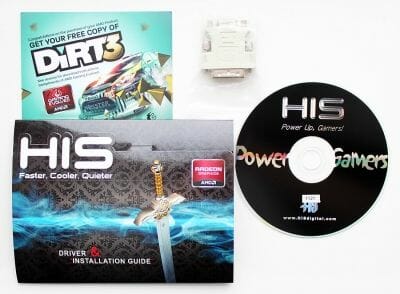
There is a minimum of accessories here: a DVI->D-Sub adapter, a DiRT 3 coupon, and a CD with drivers and utilities.
The HIS Radeon HD 6930 IceQ X 1GB comes to retail at $180. Its warranty period is 2 years.
PCB Design
The HIS Radeon HD 6930 IceQ X looks beautiful and exquisite. The turquoise color of the plastic cooler casing matches the translucent impeller of the fan, so the whole looks gorgeous.
If you look at the card from above, you can see heat pipes going out of the cooler’s base. The reverse side of the PCB is open. The card measures 260x142x42 millimeters.
The HIS Radeon HD 6930 IceQ X has a standard selection of video interfaces for a Cayman-based product: two DVI-I ports (dual-link and single-link), one HDMI version 1.4a, and two mini-DisplayPorts version 1.2.
As you can see, there is also a vent grid in the card’s mounting bracket for exhausting the hot air out of the system case.The HIS Radeon HD 6930 IceQ X has two 6-pin power connectors and two MIO connectors for CrossFireX configurations.
As opposed to Radeon HD 6970 and 6950 cards, this one lacks a BIOS selector. The peak power consumption is specified to be 200 watts in 3D mode, so HIS recommends a 500-watt or better PSU for a computer this graphics card is installed in. The power consumption is going to drop to 20 watts in 2D mode.
The HIS Radeon HD 6930 IceQ X features a custom PCB that resembles those of Radeon HD 6870 rather than HD 6950/HD 6970 cards.
The power circuit follows a 4+2 formula with four phases for the GPU and two phases for the graphics memory. It is managed by a CHiL 8214 controller from CHiL Semiconductor.
The same controller can be found on Radeon HD 68xx series products.The 40nm Cayman CE processor was manufactured in Taiwan on the 49th week of 2010(!).
If AMD supplies such old chips to its partners, we can expect them to be available in large quantities. The lifecycle of Radeon HD 6930 may turn out to be not so short after all. The GPU has the following configuration: 1280 unified shader processors, 32 raster back-ends and 80 texture-mapping units. Like the reference HD 6930, the card has a GPU clock rate of 750 MHz (at 1.16 volts) in 3D mode and 250 MHz (at 0.9 volts) in 2D mode.
The HIS Radeon HD 6930 IceQ X is equipped with 1 gigabyte of GDDR5 memory in eight FCFBGA chips located on the face side of the PCB. The chips are manufactured by Hynix Semiconductor and labeled as H5GQ1H24BFR T2C.
The rated frequency of the memory chips is 5000 MHz at a voltage of 1.5 volts, but the HIS Radeon HD 6930 IceQ X clocks them at 4800 MHz, in compliance with the official Radeon HD 6930 specifications. This gives us some headroom for good overclocking. The memory bus is 256 bits wide, providing a bandwidth of 153.9 GB/s. The memory frequency is lowered to 600 MHz in 2D mode.
Cooling System and Noise Level
The IceQ X cooler is rather simple in design. It has a copper base with nickel-plated heat pipes, an aluminum heatsink and a plastic casing with one fan.
The two central pipes are 8 millimeters in diameter. The two outermost ones are 6 millimeters. The central pipes transfer heat to the edges of the heatsink while the other pipes work its middle.
This should be effective because the temperature at the fringe of the heatsink is supposed to be lower whereas the heat pipes use direct-touch technology. On the other hand, the IceQ X cooler has only one fan right above the middle of the heatsink, so its air flow first goes to the heatsink’s center and only then to its periphery.
There is a small aluminum heatsink installed on the power circuit components. The memory chips are cooled by means of an aluminum plate with thermal pads.
We guess the cooling of the chips will even improve if you take off that plate. The PCB would also get more air for cooling in that case.The air flow is produced by an 11-blade 92x12mm fan (its impeller is 85 millimeters in diameter).The fan is ADDA’s AY09212MB20ABA0 model and runs on a dual ball bearing.
The speed of the fan is PWM-regulated within a range of 85o to 3550 RPM. It has a startup voltage of 2.8 volts and a peak power consumption of 2.5 watts.
We checked out the card’s temperature while running Aliens vs. Predator (2010) in five cycles at the highest settings (1920×1080, with 16x anisotropic filtering and 4x full-screen antialiasing). We used MSI Afterburner 2.2.0 Beta 12 and GPU-Z 0.5.8 as monitoring tools. This test was carried out with a closed system case at an ambient temperature of 26°C. We didn’t change the card’s default thermal interface.
The fan accelerates to 1830 RPM in the automatic mode, the GPU temperature rising to 76°C. At the maximum speed of 3550 RPM the GPU was no hotter than 61°C. That’s a good result for a Cayman chip, even though in a cut-down version. Now, let’s see how noisy the cooler is.
We measured the level of noise using an electronic noise-level meter CENTER-321 in a closed room about 20 sq. meters large. The noise-level meter was set on a tripod at a distance of 15 centimeters from the graphics card which was installed on an open testbed. The mainboard with the graphics card was placed at an edge of a desk on a foam-rubber tray.
The bottom limit of our noise-level meter is 29.8 dBA whereas the subjectively comfortable (not low, but comfortable) level of noise when measured from that distance is about 36 dBA. The speed of the graphics card’s fans was being adjusted by means of a controller that changed the supply voltage in steps of 0.5 V. We’ve included the results of the Sapphire Radeon HD 6870 Dirt 3 Edition and the Sapphire Radeon HD 6970 Dual Fan into the next diagram. Here are the results (the vertical dotted lines indicate the top speed of the fans in automatic regulation mode).
Alas, we can’t say that the HIS Radeon HD 6930 IceQ X is quiet because its fan is never below the comfortable level of 36 dBA, even at the minimum speed of 850 RPM. Perhaps we were unlucky to get a defective sample, but the fan of our card was rumbling and roaring at any speed. The beating of its misbalanced impeller added to its sound at low speeds. So, even though the HIS IceQ X works at a lower speed than the coolers of both Sapphire cards in automatic mode, the latter are much quieter and more comfortable for the user.
On the other hand, the reference coolers of Radeon HD 6950 and 6970 cards are even louder, so the IceQ X is quite a good alternative to them.
Overclockability
Although the HIS card is in fact based on a defective Cypress chip, its overclocking potential proved to be high. Our sample was stable at a GPU clock rate of 920 MHz (+22.7% to the default value) and a memory clock rate of 5720 MHz (+36.2%).
The reference Radeon HD 6970 works at 880/5500 MHz and our sample of the HIS card could beat these frequencies. We’ll see soon if it will be able to deliver higher performance in tests. Let’s take a look at the temperature of the overclocked card.
The peak GPU temperature grew by 4°C whereas the fan accelerated by 100 RPM, reaching 1930 RPM. That’s a very good result.
Power Consumption
We measured the power consumption of computer systems with different graphics cards using a multifunctional panel Zalman ZM-MFC3 which can report how much power a computer (the monitor not included) draws from a wall socket. There were two test modes: 2D (editing documents in Microsoft Word and web surfing) and 3D (the benchmark from Metro 2033: The Last Refuge at 1920×1080 with maximum settings). Here are the results.
The systems with different AMD-based graphics cards are very close to each other in power consumption. For example, the Radeon HD 6930 configuration needs only 20 watts less than the HD 6970 configuration whereas the system with the least advanced Radeon HD 6870 needs a mere 15 watts less. Notwithstanding the six-core CPU, each configuration can be powered by a 500-watt PSU.
7970. Well, this difference can hardly be noticed in your electricity bill anyway.
Testbed Configuration and Testing Methodology
All graphics cards were tested in a system with the following configuration:
- Mainboard: Intel Siler DX79SI (Intel X79 Express, LGA 2011, BIOS 0380 from 11/28/2011);
- CPU: Intel Core i7-3960X Extreme Edition, 3.3 GHz, 1.2 V, 6 x 256 KB L2, 15 MB L3 (Sandy Bridge-E, C1, 32 nm);
- CPU cooler: Phanteks PH-TC14PE (2 x 140 mm fans at 900 RPM);
- Thermal interface: ARCTIC MX-4;
- System memory: DDR3 4 x 4GB Mushkin Redline (Spec: 2133 MHz / 9-11-10-28 / 1.65 V);
- Graphics cards:
- Sapphire Radeon HD 6970 Dual Fan 2 GB/256 bit GDDR5, 880/5500 MHz;
- Sapphire Radeon HD 6870 Dirt 3 Edition 1 GB/256 bit GDDR5, 900/4200 MHz;
- HIS Radeon HD 6930 IceQ X 1 GB/256 bit GDDR5, 750/4800 MHz and 920/5720 MHz;
- System drive: Crucial m4 256 GB SSD (SATA-III,CT256M4SSD2, BIOS v0009);
- Drive for programs and games: Western Digital VelociRaptor (300GB, SATA-II, 10000 RPM, 16MB cache, NCQ) inside Scythe Quiet Drive 3.5” HDD silencer and cooler;
- Backup drive: Samsung Ecogreen F4 HD204UI (SATA-II, 2 TB, 5400 RPM, 32 MB, NCQ);
- System case: Antec Twelve Hundred (front panel: three Noiseblocker NB-Multiframe S-Series MF12-S2 fans at 1020 RPM; back panel: two Noiseblocker NB-BlackSilentPRO PL-1 fans at 1020 RPM; top panel: standard 200 mm fan at 400 RPM);
- Control and monitoring panel: Zalman ZM-MFC3;
- Power supply: Xigmatek “No Rules Power” NRP-HC1501 1500 W (with a default 140 mm fan);
- Monitor: 30” Samsung 305T Plus.
It would make more sense to also include Radeon HD 6950, but unfortunately, I didn’t have this particular graphics card at my disposal at the time of tests, so I had to fill in the gaps with a Radeon HD 6970 from Sapphire. I have to point out, though, that I didn’t stay upset about the missing Radeon HD 6950 for long…
In order to lower the dependence of the graphics cards performance on the overall platform speed, I overclocked our 32 nm six-core CPU with the multiplier set at 37x, BCLK frequency set at 125 MHz and “Load-Line Calibration” enabled to 4.625 GHz. The processor Vcore was increased to 1.45 V in the mainboard BIOS.
Hyper-Threading technology was enabled. 16 GB of system DDR3 memory worked at 2.133 GHz frequency with 9-11-10-28 timings and 1.65V voltage.
The test session started on February 3, 2012. All tests were performed in Microsoft Windows 7 Ultimate x64 SP1 with all critical updates as of that date and the following drivers:
- Intel Chipset Drivers 9.3.0.1019 WHQL from 12/22/2011 for the mainboard chipset;
- DirectX End-User Runtimes libraries from November 30, 2010;
- AMD Catalyst 12.1 driver from 01/25/2012 + Catalyst Application Profiles (CAP1) from 02/03/2012 for AMD based graphics cards.
The graphics cards were tested only in one the most popular in our opinion resolution of 1920×1080. The tests were performed in two image quality modes: “Quality+AF16x” – default texturing quality in the drivers with enabled 16x anisotropic filtering and “Quality+ AF16x+MSAA4(8)x” with enabled 16x anisotropic filtering and full screen 4x anti-aliasing (MSAA) or 8x if the average framerate was high enough for comfortable gaming experience. We enabled anisotropic filtering and full-screen anti-aliasing from the game settings or configuration files. If the corresponding options were missing, we changed these settings in the Control Panels of Catalyst drivers. We also disabled Vsync there. There were no other changes in the driver settings.
The list of games and applications used in this test session remains the same and includes two popular semi-synthetic benchmarking suites, one technical demo and 15 games of various genres. However, we didn’t set the image quality settings to the maximum in some of them, to ensure that the performance was sufficient for comfortable gaming experience:
- 3DMark Vantage (DirectX 10) – version 1.0.2.1, Performance and Extreme profiles (only basic tests);
- 3DMark 2011 (DirectX 11) – version 1.0.3.0, Performance and Extreme profiles;
- Unigine Heaven Demo (DirectX 11) – version 2.5, maximum graphics quality settings, tessellation at “extreme”, AF16x, 1920×1080 resolution with MSAA 4x;
- S.T.A.L.K.E.R.: Call of Pripyat (DirectX 11) – version 1.6.02, Enhanced Dynamic DX11 Lighting profile with all parameters manually set at their maximums, we used our custom cop03 demo on the Backwater map;
- Left 4 Dead 2 (DirectX 9) – version 2.0.8.8, maximum graphics quality settings, d81 demo (two runs) on “Gold Stream (Beta)” map of the “Alpine Greek” level;
- Metro 2033: The Last Refuge (DirectX 10/11) – version 1.2, maximum graphics quality settings, official benchmark, “High” image quality settings; tesselation, DOF and MSAA4x disabled; AAA aliasing enabled, two consecutive runs of the “Frontline” scene;
- Just Cause 2 (DirectX 11) – version 1.0.0.2, maximum quality settings, Background Blur and GPU Water Simulation enabled, two consecutive runs of the “Dark Tower” demo;
- Aliens vs. Predator (2010) (DirectX 11) – Texture Quality “Very High”, Shadow Quality “High”, SSAO On, two test runs in each resolution;
- Lost Planet 2 (DirectX 11) – version 1.0, maximum graphics quality settings, motion blur enabled, performance test “B” (average in all three scenes);
- StarCraft 2: Wings of Liberty (DirectX 9) – version 1.4.2, all image quality settings at “Extreme”, Physics at “Ultra”, reflections On, two 2-minute runs of our own “bench2” demo;
- Sid Meier’s Civilization V (DirectX 11) – version 1.0.1.348, maximum graphics quality settings, two runs of the “diplomatic” benchmark including five heaviest scenes;
- Tom Clancy’s H.A.W.X. 2 (DirectX 11) – version 1.04, maximum graphics quality settings, shadows On, tessellation Off (not available on Radeon), two runs of the test scene;
- Total War: Shogun 2 (DirectX 11) – version 2.0, built in benchmark (Sekigahara battle) at maximum graphics quality settings;
- Crysis 2 (DirectX 11) – version 1.9, we used Adrenaline Crysis 2 Benchmark Tool v.1.0.1.13. BETA with “Ultra High” graphics quality profile and activated HD textures, two runs of a demo recorded on “Times Square” level;
- DiRT 3 (DirectX 11) – version 1.2, built-in benchmark at maximum graphics quality settings on the “Aspen” track;
- Hard Reset Demo (DirectX 9) – benchmark built into the demo version with Ultra image quality settings, one test run;
- Batman: Arkham City (DirectX 11) – version 1.2, maximum graphics quality settings, physics disabled, two sequential runs of the benchmark built into the game.
- Battlefield 3 (DirectX 11) – version 1.3, all image quality settings set to “Ultra”, two successive runs of a scripted scene from the beginning of the “Going Hunting” mission 110 seconds long.
If the game allowed recording the minimal fps readings, they were also added to the charts. We ran each game test or benchmark twice and took the best result for the diagrams, but only if the difference between them didn’t exceed 1%. If it did exceed 1%, we ran the tests at least one more time to achieve repeatability of results.
Performance
3DMark Vantage
The standings of the graphics cards in the first test correspond to their recommended pricing. The new Radeon HD 6930 is somewhat faster than the HD 6870 and 20% slower than the HD 6970. When overclocked, it gets closer to the HD 6970, the gap shrinking to 7-9%.
3DMark 2011
The overclocked Radeon HD 6930 is even closer to the HD 6970 in 3DMark 2011. The gap is a mere 2-4%. When clocked at its default frequencies, the HD 6930 is somewhat ahead of the Radeon HD 6870.
Unigine Heaven Demo
Working at 920/5720 MHz, the Radeon HD 6930 proves to be able to deliver the same performance as the Radeon HD 6970 at 880/5500 MHz which costs twice the money. We should also note that the Radeon HD 6930, when clocked at its default frequencies, delivers the same performance as the Radeon HD 6870. The latter’s higher GPU frequency helps it keep up with the newer card.
S.T.A.L.K.E.R.: Call of Pripyat
Working at its default clock rates, the Radeon HD 6930 is but barely ahead of the Radeon HD 6870 but can compete with the HD 6970 when overclocked. The HD 6970 is faster when we enable antialiasing, though.
Left 4 Dead 2
The graphics cards are all very fast in Left 4 Dead 2. The average frame rate is never lower than 130 fps. The standings are the same as in S.T.A.L.K.E.R.: Call of Pripyat, though.
Metro 2033: The Last Refuge
The game produced the same results irrespective of whether we enabled FSAA or not. Therefore we tested the graphics cards in the FSAA-less mode only.
As opposed to the previous game, the graphics cards deliver very low frame rates even though the game settings weren’t set at their maximums. The Radeon HD 6930 overtakes the HD 6970 when overclocked and is somewhat faster than the HD 6870 when left at default frequencies.
Just Cause 2
This test agrees with the previous one.
Aliens vs. Predator (2010)
Aliens vs. Predator is as heavy a test as Just Cause 2. When overclocked to 920/5720 MHz, the Radeon HD 6930 can get close to the Radeon HD 6970 yet cannot overtake it.
Lost Planet 2
AMD-based products are not generally fast in Lost Planet 2. The overclocked Radeon HD 6930 easily overtakes the non-overclocked HD 6970. Working at its default frequencies, it is ahead of the Radeon HD 6870. The same goes for the next three games: StarCraft II: Wings of Liberty, Sid Meier’s Civilization V and Tom Clancy’s H.A.W.X. 2.
Total War: Shogun 2
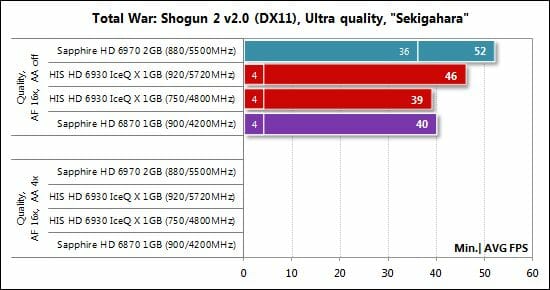
What makes this game different from the previous ones is that the Radeon HD 6930 and HD 6870 feel a lack of graphics memory. They only have 1 gigabyte of it. Besides having a very low bottom speed, these cards were unable to run the test with antialiasing turned on.
Crysis 2
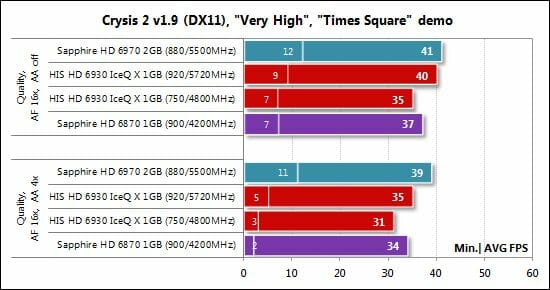
The bottom speed of the Radeon HD 6930 and HD 6870 is low in Crysis 2, too. The Radeon HD 6970, having more memory, beats them in this respect, especially with enabled antialiasing. Besides, this test is special because the Radeon HD 6870 beats the HD 6930 when both work at their default clock rates. This is thanks to the higher frequency of the Barts XT processor.
DiRT 3
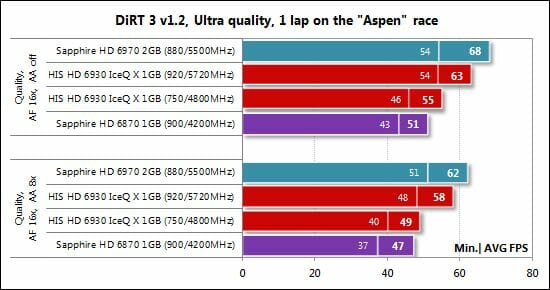
DiRT 3 doesn’t produce anything unexpected. Its results agree with those of most other tests.
Hard Reset Demo
The Radeon HD 6930 and Radeon HD 6870, each with 1 gigabyte of onboard memory, have problems with the bottom frame rate in Hard Reset Demo. They can only deliver 10-12 fps whereas the Radeon HD 6970 2GB never slows down below 35 fps. The standings are normal in the MSAA-less mode.
Batman: Arkham City
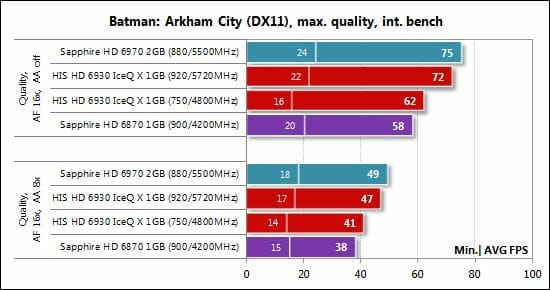
This game ranks the graphics cards as accurately as 3DMark Vantage.
Battlefield 3
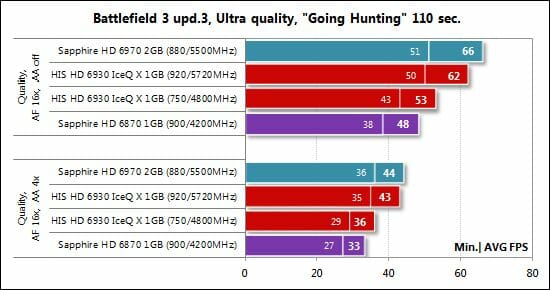
The standings are the same as in the previous tests. So, let’s move on to summary diagrams.
Summary Diagrams
The first summary diagram compares the Radeon HD 6930 1GB with the Radeon HD 6870 1GB, both working at their default clock rates. They have the same price, too.
Save for Crysis 2 and one test mode of Tom Clancy’s H.A.W.X. 2 and Total War: Shogun 2, the new Radeon HD 6930 is faster than the HD 6870. It enjoys an average advantage of 3.7% in the AA-less mode and 5.4% with enabled antialiasing. The difference is small, yet the cards cost the same money, so the faster version is obviously preferable.
Now let’s see how slower the Radeon HD 6930 is in comparison with the Radeon HD 6970.Compared to the top-end card of the previous generation, the new Radeon HD 6930 is an average 17.7% and 19% slower without and with MSAA, respectively. This is a larger gap than the one between the HD 6930 and HD 6870 but the HD 6930 is only half as expensive as the HD 6970! Besides, it can be accelerated by overclocking to 920/5720 MHz.
The Radeon HD 6970 is an average 3-4% ahead of the new card now, which makes the latter a very attractive buy. The only downside is that overclocking cannot make up for the lack of graphics memory in games that demand a lot of it. The Radeon HD 6930 1GB is going to be slow in such games even when overclocked.
Conclusion
The AMD Radeon HD 6930 is undoubtedly one of the most attractive graphics cards in terms of the price/performance ratio. At only half the cost of a Radeon HD 6970, you can get the same performance (if you don’t mind overclocking, of course). An HD 6970 can be overclocked itself and an HD 6950 can be unlocked, but they cost much more than the HD 6930.
The new card is also good in comparison with the Radeon HD 6870 as it costs the same money but delivers somewhat higher performance. So, the only real downside is that the lifecycle of the Radeon HD 6930 is not going to be long. The Pitcairn processor and appropriate cards are coming up while the current stock of defective Cayman chips can’t last forever.
As for the HIS Radeon HD 6930 IceQ X, we don’t like its roaring and rumbling fan with misbalanced impeller. Hopefully, this is just a defect of our sample of the card rather than of the entire series. Otherwise, we can’t recommend this card to users who prefer quiet computers. Apart from the fan, it is a pretty and rather compact device with good cooling, excellent overclocking potential and a price of only $180. It should appeal to thrifty gamers who couldn’t previously afford a Radeon HD 6950 or HD 6970.